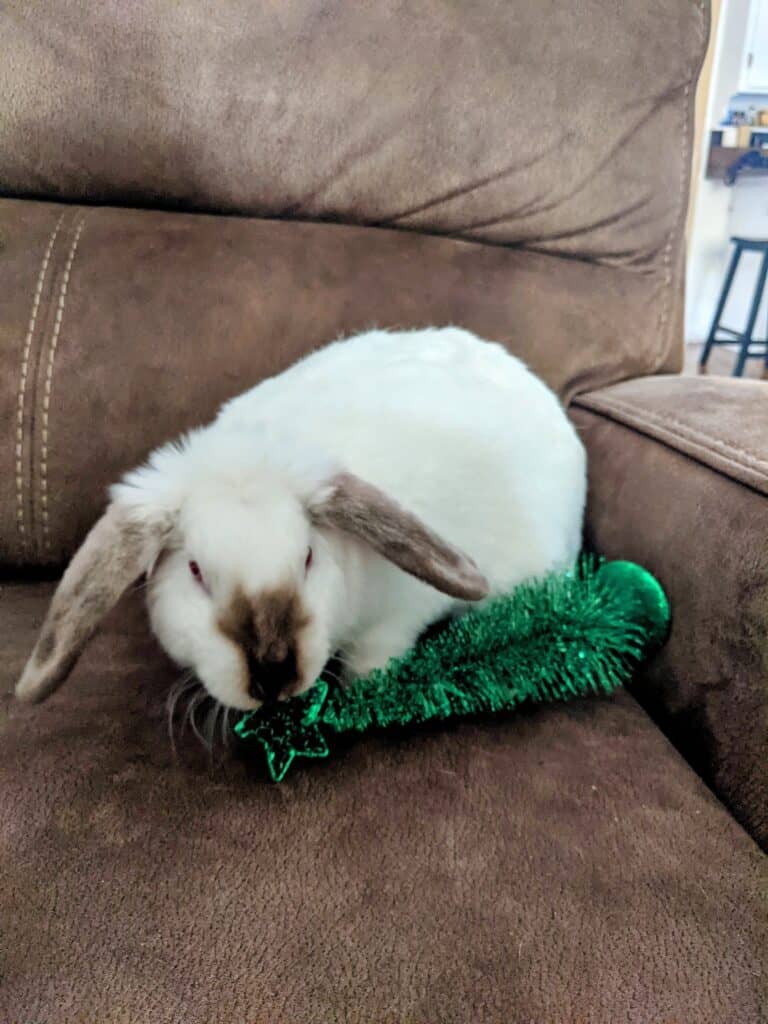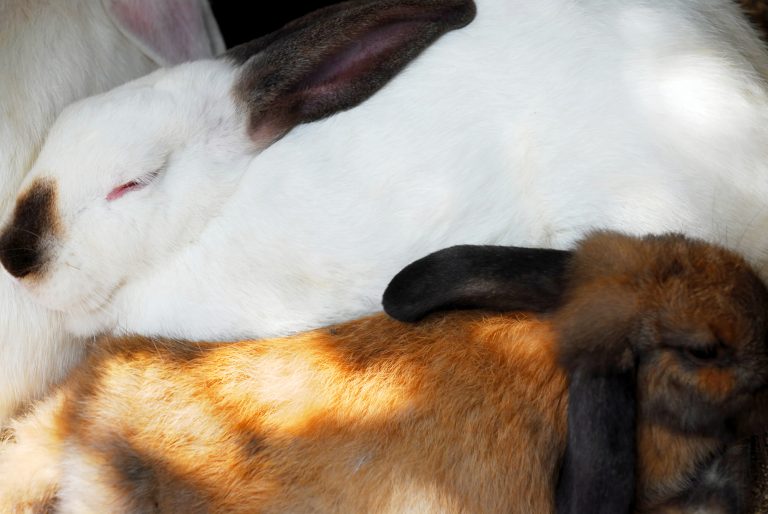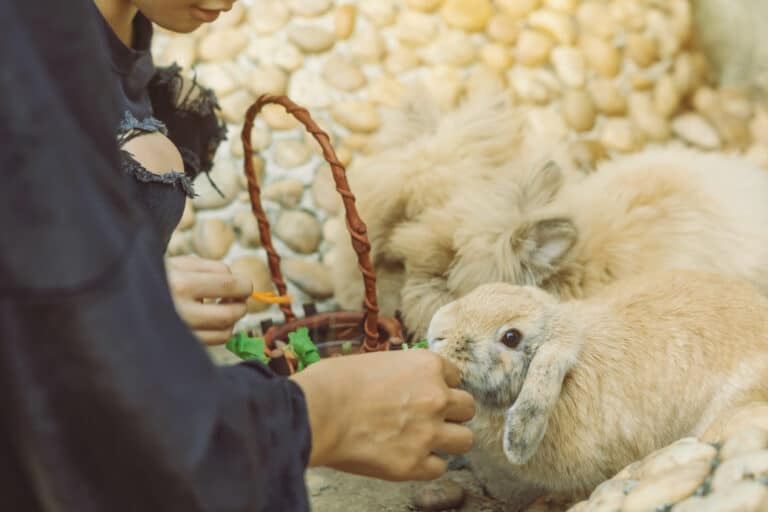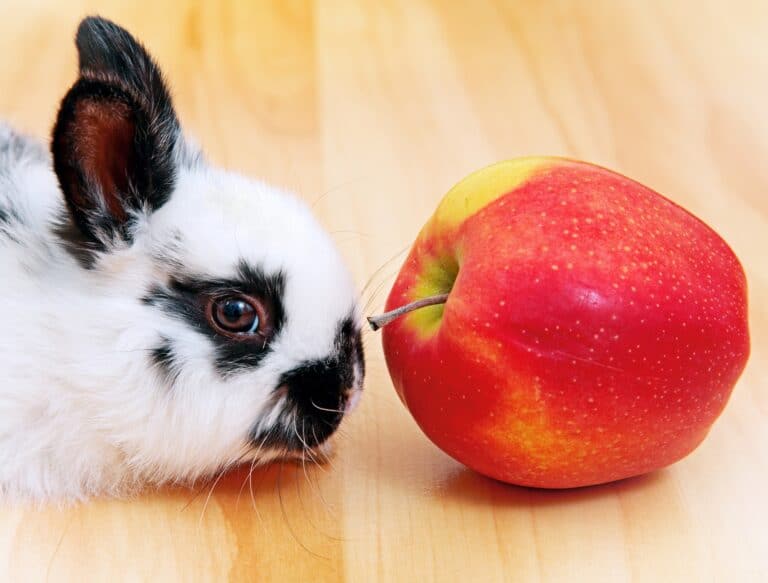What Do Baby Rabbits Eat?

Has your bun given birth recently, and you’re wondering what to feed the little ones? In most instances, you get to sit back and relax during the baby rabbits’ early days because they need only their mother’s milk to survive. However, as the bunnies mature, you’ll have to start adding to their diet. The question is, what do baby rabbits eat? Let’s see what those cute little bunnies require to grow healthy and strong.
This post contains affiliate links. Affiliate links support Every Bunny Welcome at no additional cost to you. I receive a commission if you choose to make a purchase through these links.

Do You Need to Feed Baby Rabbits?
As we mentioned, baby rabbits or kittens (kits) live exclusively on their mother’s milk from birth until they’re around 3 weeks old. As such, you don’t have to give them anything during that time.
If you’re a new bun parent, don’t be surprised if you don’t see the mother rabbit feeding her young. Unlike other animals, such as cats and dogs, mother buns nurse their babies for short periods, around 5 minutes, and typically only once a day. So it’s easy for you to miss the feeding.
Being prey animals, mother rabbits in the wild don’t hang around the nest area to prevent the young from becoming targets by predators. Also, because their milk is calorie-dense, the kits get their nutritional requirements despite the limited feeding session.
However, there are instances when the mother bun ignores her newborns and leaves them before they can survive on their own. In such cases, you’ll need to take action. Rabbits can live without food for only around 3 to 4 days at most, so you’ll have to feed the kits.
But if the mother bun is present and her babies seem content, just let nature take its course.
Baby Rabbit’s Eating Pattern
When kits are born, their mother’s milk will supply all their nutritional needs. That’s why they shouldn’t be separated from their mother until they can eat other foods.
Around the two-week mark, the buns will start to nibble on hay, and when they’re between 3 and 4 weeks, they’ll start eating the same food as their mother. However, they will continue drinking her milk until they’re 6 to 8 weeks old. After that, they can start living completely on solid food.
What Should They Eat?
The first six months of a baby rabbit’s life play a significant role in its long-term health. That’s why feeding the growing kits the right food is critical to their well-being.
After weaning, baby rabbits can eat the same food you give your adult buns. However, you’ll need to make a few adjustments because kits require more protein and calcium than grown rabbits.
Here’s what should comprise a baby bun’s diet.
Hay
Because they’re herbivores, rabbits require a plant-based diet. Adult rabbits typically eat Timothy Hay. However, kits should get Alfalfa Hay as it contains more protein and calcium, which growing buns need. Fortunately, Alfalfa Hay is softer and has a sweeter taste than Timothy Hay, making it appealing to baby rabbits.
Hay promotes healthy digestion and is also good for rabbits’ teeth. Chewing on the fibrous material helps trim their pearly whites that never stop growing throughout their life.
Hay forms the bulk of a rabbit’s diet throughout its life, so start them young. Give the kits an unlimited supply. Hay won’t make up as large a percentage of their diet as their adult counterparts but make sure they have constant access to it.
Mix Alfalfa Hay with a small portion of grass hay to make it easier to transition the kits to other hay types when they’re older.

Pellets
Pellets are not a critical component of an adult rabbit’s diet. However, the case is different when it comes to baby buns. Because they’re growing and developing, kits require higher levels of nutrients than hay can provide.
Make sure you choose pellets specially made for baby rabbits, as they’re designed to meet the requirements of growing buns. Stay away from blends that contain dried fruits, seeds, or veggies. Those pellet brands often have high sugar content and components that might not agree with the young rabbits’ digestive system.
Rabbits need hay in their diet more than pellets. However, because pellets are tastier, buns often prefer them to hay. Observe their behavior to determine how much of this food item to give your kits. If they’re ignoring their hay because they prefer pellets, limit the portion of pellets you provide. Around ¼ cup for every 2 pounds of rabbit weight per day is a rough guide.
Make sure, though, that the kits are gaining enough weight and look energetic and happy. If not, adjust their portions accordingly.
Leafy Greens
Start offering leafy greens only when the baby rabbits are 3 months old, not before. Rabbits have sensitive digestions, particularly when they’re young. Eating foods that their digestive tract can’t properly process can lead to stomach issues.
Parsley, broccoli leaves, carrot tops, and kale are some leafy greens that suit baby rabbits. But slowly introduce one type of leaf at a time to allow the little ones to get used to it.
At the start, offer only a tiny portion of leafy greens. The digestion of baby rabbits is very sensitive, and gets easily upset. So when you first introduce leafy greens, a small leaf or two should suffice. You can increase the amount as their digestion adjusts to the new food.
Fruits
Rabbits have a sweet tooth, so most love fruits. However, fruits should be considered as treats. Their high sugar content isn’t good for buns, regardless of age. In any case, rabbits younger than 12 weeks shouldn’t get fruits due to their sensitive digestive tracts.
When the little ones are old enough, you can give fruits sparingly. Don’t let the young bunnies eat fruit more than once a week. A small slice of apple, one tiny orange wedge, and a bite of grapes will suffice.
Water
Don’t forget this essential component of your kits’ diet. Once the young bunnies are fully weaned from their mother, they should have access to water 24/7 to prevent dehydration.
It’s better to place the water in a bowl instead of a bottle, as this is a more natural way for rabbits to drink. But if the bunnies are messy drinkers, you can use a bottle for the time being. Try introducing the bowl when they’re a bit older.
Rabbits of all ages should have constant access to clean and fresh drinking water. Remember to check their supply and top up as needed.
How to Tell If Your Rabbit Is Eating the Right Food
Rabbits grow at different rates, so you can’t tell by the kits’ sizes if they’re eating enough or the right food. However, some signs will let you know that they’re thriving. Here are some indicators.
- Energy level: Well-nourished buns are active little balls of fluff.
- Weight: Kits should have a certain amount of body fat. You should be able to feel their ribs, hips, and spine, but the outline of the bones shouldn’t be easy to make out.
- Poop: The poop of healthy rabbits is round and firm, not squishy or deformed. Young kits should also produce little, soft clusters called cecotropes, which they eat. Take note if they’re pooping regularly.
- Appetite: Healthy rabbits love to eat, so the young buns should look forward to their feeding time. It’s dangerous for rabbits to stop eating and is a sign that something’s not right.
Rabbits grow up fast. That’s nature’s way of boosting their survival in the wild. Knowing what baby rabbits eat will help you give your little buns the food they need to ensure a healthy growth rate.
More on Your Rabbit’s Diet
- Is Orchard Hay Good for Rabbits?
- The Best Lettuce for Rabbits: What Type Can They Eat
- Complete Guide to the Best Hay For Rabbits: Reviews & More
- What Can You Feed Wild Rabbits: A Comprehensive Guide
- Can Rabbits Have Cabbage? What You Need to Know!
We hope you enjoyed this post! If you did, will you give it a share or two 🙂 Thank you! ~from Every Bunny Welcome







